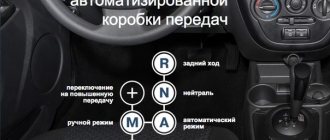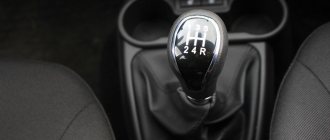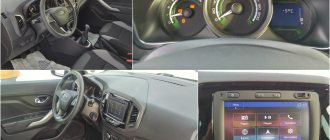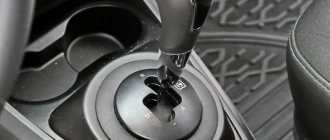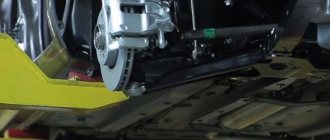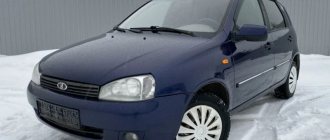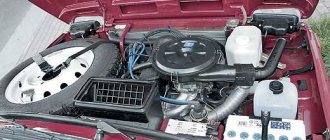Reviews about the Niva Urban published to date say that the new car in terms of cross-country ability is not inferior to foreign SUVs, which cost an order of magnitude more. However, there are some disadvantages.
I purchased the car after a test drive. While still in the salon, I noticed that the quality of the paintwork had changed: to the touch it began to more closely resemble the coating of a foreign car. The difference from previous versions immediately caught my eye: for some reason the bumper cover was made of plastic, which suggests that it is better not to drive off-road.
The seats have also changed: they have become more ergonomic, the level of comfort has increased, and when turning, you remain sitting in place, and do not move to the side, as was before. I was pleased with the rear mirror, equipped with an electric drive - an unexpected solution for a car of this class.
The manufacturer has made efforts to make the new Niva Urban not just a car for fishermen and off-road driving enthusiasts, but also for people who value comfort: this is what explains the absence of window lifter handles and the presence of air conditioning in each trim level.
I've only driven a bit so far: in general, you can begin to evaluate the reliability and performance of machine components after at least 20 thousand kilometers.
I think that the car is perfect for city residents.
Sergey. Possession period is 3 months.
But not all Niva Urban owner reviews are good: below you can read the opinion of a person who was not so lucky with his purchase.
After the purchase, I drove the car home from the dealership: I immediately decided to check the car’s cross-country ability, so I didn’t leave the car 300 meters from the entrance, but drove straight to the door off-road. But after inspection, I discovered that a self-tapping screw had fallen out of the fuse block cover: despite efforts, I couldn’t screw it back in. It's a small thing, but unpleasant. Another negative point is that the doors close with great difficulty: you have to slam with all your might, like on a truck. Let's go further: we filled the tank full, but the arrow on the display shows only half. Regarding the possibility of correcting all of the above problems, I will go to the official dealer.
Ivan. Holding period is 5 days.
An acquaintance needed a car to travel outside the city, but at the same time it would be comfortable to drive in city conditions. We paid attention to Niva Urban. We read the reviews and decided to write our own.
The impressions from the purchase are rather positive, but first things first.
First the cons:
- poor sound insulation: when driving fast, you almost have to shout so that the person sitting in the next seat can hear the words;
- unadjusted gas tank and trunk lid: if the first one opens even more or less, then physical force will be required to open the second one;
- poor quality of handles and locks - I wouldn’t be surprised if they break due to constant off-road driving.
Something constantly breaks: the owner's review of the 5-door Niva 4x4 2131. Its disadvantages and problems
I’m not belittling its merits, but this car is not for me: something constantly breaks in it, cracks, makes noise, squeaks...
I only had Mercedes and BMW cars (not new), but I always had the feeling that something was missing and I wanted something more for primers, turns, forests... Therefore, I chose a car based on the fact that it would be possible to get there anywhere, and without sparing the technology itself. The cheapest option turned out to be Niva, so I bought it new, only the five-door 2131. The car is a year old, but I think that the 2022 Niva 2131 will be similar. And 2025...
I’m generally happy with the car, I knew what I was getting into, but the Niva 2131 has some disadvantages and problems, which I’ll tell you about in my owner review (I’m not saying, but I think that the long 5-door and 3-door have similar problems).
1. The stove is very noisy, it blows from under the entire panel, but the air does not reach the side windows. As such, a comfortable temperature regime simply does not exist. Although I realized later that comfort and Niva are incompatible things.
2. When accelerating, the coolant temperature arrow inevitably tends deeper into the red zone, but after running the car, the problem went away.
3. It is impossible to accurately determine the fuel level using the sensor - it shows everything except the exact amount of gasoline.
4. The transfer case constantly howls, and the fuel pump squeaks, a typical problem of the Niva 4x4, judging by the reviews of the owners of 2131 and 2121.
5. Including electrical consumers, the voltage drops noticeably.
6. The driver's door does not close well.
Gradually I realized that if you want to drive a Niva, you will have to get used to all this, and in general, the Niva is a completely new world. Something is always noisy here and refuses to work, and fixing the problems that arise and bringing the car to perfection is a completely thankless task: having gotten rid of the squeal of the transfer case, you are faced with noise in the bridge, etc. The main criterion is that if the car drives, then everything is fine with it. You should only pay attention to those faults that cause the car to stop moving. Another interesting point: each Niva is a unique specimen, just like a manual assembly, each has its own problems and shortcomings about which so many reviews have already been written. For example, in one car the transfer case vibrates and squeals, but in another it does not. This applies to all nodes.
It was a slight retreat. The car became the second one in the family and was used for trips into nature. In the first six months I covered about 5 thousand kilometers in the Moscow region. When the odometer showed 800 km and was in the Moscow region, the headlights went out and an error indicator appeared on the panel. This all happened during the day, I have no experience in repairs, I couldn’t find anything about this on the Internet, so I had to go back in search of a service, which was found a hundred kilometers later. Unfortunately, they couldn't help there either. The only option left was to take the car to the dealer and have the problem repaired under warranty. Fortunately, everything was done - the problem was with some wire, but the car caused a ruined vacation. How Niva 4x4 was able to survive until 2022 and still collect admiring reviews from owners with a bunch of minuses and problems and a couple of pluses is a question.
Replacement of the generator at 3 thousand mileage. At first they convinced me that the generator was working normally; apparently, in order for it to be considered faulty, no current should have been produced at all. By the way, I drew the service’s attention to the squealing of the fuel pump, but they said that if it works, then nothing needs to be done. The quality of spare parts is very low, and if you have to change them, it is better to use original ones, which are installed during assembly. Several times I have encountered the fact that even simple parts, such as reinforced rods, break after a few days. This does not apply to all spare parts, but to many.
As a result, I realized that servicing the Niva requires my own garage, repair skills and a lot of free time, which I did not have. There is only one plus - it’s not far from the dealer. It’s convenient to drive your car in the morning and pick it up after work.
I won’t write much about the positive aspects and advantages of the Niva 4x4 and the long 5-door 2131; the owners have already described them all in their reviews. First of all, excellent cross-country ability already in stock. In the city I don’t even pay attention to bumps and hatches, I stupidly drive straight. Of all the all-wheel drives, the Niva is the cheapest, and for peripherals it’s the best! In the event of a breakdown, it is not difficult to repair; any garage can do it for little money. But with my work and constant traffic jams in Moscow, it’s impossible to do this. In principle, the big one plus is cross-country ability, and then there are the disadvantages and problems without which Niva would not be Niva.
By the way, about rust. The other day a friend showed me a photo of rust on the welds of the front struts. His car is the same as mine, with the same mileage (just not a 5-door). I decided to see how things were going with this for me, and sadness came. Although immediately after purchase I treated it with anti-corrosion agent, as well as the struts, but it didn’t help much - the car is a year old and rust has already set in. I also noticed some rust on the chrome trim on the windows.
Rust is not a minus, it’s a mega drawback on the Niva 2131. I can imagine what will happen in 2022. But these are already problems for the new owner
In short, I decided to sell it; instead, I’d rather buy a Solaris on the machine for my wife. The result of my review from the owner of Niva 4x4 2131 is a good and cheap SUV, and even roomy in the 5-door long version (by the way, another plus besides cross-country ability), but not for me, rather for a certain circle of people who have free time and a desire to delve into the car .
Photo and test with editing: media.auto.ru/review/cars/vaz/2131_4x4/20370949/4040618
Purchase history
So, NIVA, VAZ 2131 Urban. Why did you take her? Two reasons: the first is economic. Like the majority of Russians, I lost a significant amount of income after 2014 (the reasons are known to everyone), secondly, I needed a large car with all-wheel drive, but not more expensive than 500-600 thousand rubles.
In our country, in this category it is only the long-wheelbase NIVA. Yes, there is also a UAZ Patriot, but in normal configuration it already costs 1 million rubles, and I don’t have my own garage at the moment.
Why Urban? Yes, because we live in Russia, where the average temperature ranges from -30 to + 30 degrees. And, as recent years have shown, this range is only expanding. Therefore, a Russian car must have not only all heating, but also air conditioning (ideally, of course, climate control).
In the field of labor
Is it worth buying a used Niva? When creating the first SUVs, almost no manufacturer thought about such a component as comfort.
And why would this be, if the main consumers of such machines then were the armed forces. But over time, many people thought about developing a car that combines the high cross-country ability of an SUV and the comfort of a family sedan. It is gratifying that our country was one of the pioneers in this. The history of the creation of the domestic SUV that is still produced today began in the summer of the distant 1970. Chairman of the Council of Ministers Alexey Nikolaevich Kosygin paid a visit to the newly launched Volzhsky Automobile Plant. Then the question arose about the possibility of creating a comfortable 4x4 vehicle designed for agricultural workers. At that time, one phrase from a high official was enough to start work on an all-wheel drive vehicle. And not only at VAZ. Many automobile factories of the USSR presented their projects. It cannot be said that the birth of a compact all-terrain vehicle was simple. Only seven years after Kosygin’s visit, on April 5, 1977, serial production of the VAZ2121 began. But the result was impressive. Suffice it to say that the design of the car turned out to be so innovative for that time that many of the ideas used on it subsequently migrated to models of the world's leading vehicles, and it still remains the most popular SUV in Russia.
Body and interior
Unlike the vast majority of all-terrain vehicles thirty years ago, the Niva does not have a supporting frame. Its role is performed directly by the power structure of the body. Like all products from domestic manufacturers, its corrosion resistance leaves much to be desired. Therefore, thrifty owners perceive annual anti-corrosion treatment of their car as inevitable, akin to trips to scheduled maintenance.
However, even if this rule is followed, few people succeed in delaying the formation of through holes in the thresholds for a long time. In addition, it is necessary to carefully monitor the condition of the ventilation holes in the lower edges of the doors and thresholds (if they are clogged with dirt or anticorrosive compounds, then moisture begins to accumulate in the internal cavities of these parts, which significantly accelerates the corrosion process). When a car is frequently exposed to domestic anti-icing reagents, the side members in the front part of the car rust very quickly, and traces of corrosion in the places where body parts are welded may appear already in the first year of operation. But perhaps the most vulnerable spot is the part of the floor in the area where the transfer case is mounted. If not properly treated, it simply rots. Vibrations from the transmission contribute no less to the destruction of this area. Therefore, many experienced “field workers”, who often leave hard surfaces, reinforce this place with an additional sheet of iron. The pre-restyling version of the Niva with the factory index 2121 had a short trunk door: its lower edge is one of the fastest rotting places in the car. On the updated model 21213, the cargo compartment door opening was lowered to the rear bumper, and the corrosion resistance of the third door was slightly increased. By the way, if on the VAZ-2121 it can only be opened from the outside, then on the modernized version it can be opened exclusively from the interior using a handle located at the rear left passenger’s knee.
An interesting feature in the body design for those who often use the Niva as a tow truck. If the front towing eye is screwed directly to the side member and can withstand heavy loads, the rear one is attached to the joint of three body parts, so there are cases when, under heavy loads, it was torn out along with part of the elements of the body itself
Engine
The first production VAZ-2121 was equipped with a 1.6-liter carburetor engine, inherited from the VAZ-2106. The engine had an overhead camshaft drive via a multi-row roller chain. In general, the power unit is considered quite reliable and unpretentious. A little later, for countries where the tax depends on engine size, a version with a 1.3-liter engine was prepared. In our country, such specimens are practically never found. After modernization in 1994, the car, which received the index 21213, began to be equipped with a 1.7-liter carburetor engine with a contactless ignition system. Compared to its predecessor’s unit, it had noticeably better low-end traction, but was more prone to detonation when consuming low-quality fuel. The VAZ-2131 was equipped with 1.8 liter engines.
On all carburetor versions, the cooling system used a radiator fan mechanically driven from the crankshaft. A significant disadvantage of this scheme is the insufficient air flow to the radiator when the engine is idling. Therefore, in traffic jams, especially in hot weather, the operating temperature very quickly rises above the critical value. The result is a banal overheating, which, if not prevented in time, can lead to serious engine repairs. This problem was eliminated only with the advent of the VAZ-21214, which installed two electric fans. These cars do not have frequent problems with overheating. In addition, the engine of this version received an injection system instead of a carburetor. Both central GM and multi-point Bosch were used. The gas distribution system was also slightly reworked, using hydraulic lash compensators in the valve drive. On the one hand, this innovation helped to get rid of the frequent procedure for adjusting them, and on the other, the engine became more demanding on the quality of the oil.
Expert opinion
The most common engine malfunctions on the Niva are: the timing chain tensioners and dampers fail, after major repairs the fourth cylinder partition becomes thinner, and the engine begins to overheat. On machines 2121 and 21213, a mechanically driven fan was installed, so the engine often overheats at idle speed.
Regarding the transmission: fifth gear often “flies out”, since the load on the gearbox designed for the VAZ-2106 is much higher here. The clutch usually withstands 40–50 thousand km, but when doing off-road work it can be burned out in one day. The elastic shaft coupling wears out over time, resulting in significantly increased vibrations. Crosses require regular maintenance.
The ball joints in the front suspension also last 40–50 thousand. The upper right rear silent block, located next to the exhaust system, overheats and fails faster than others. Sometimes the support axis of the front lower arm bends and has to be strengthened. The wear of steering rods is influenced by driving style - for “racers” they fail earlier.
Transmission
The highlight of the car is permanent all-wheel drive. From the very first Niva to this day, the scheme has not changed. A symmetrical free differential is used as a mechanism that distributes torque between the axles. To increase cross-country ability, it has the ability to force lock. In addition, as befits a serious SUV, the transfer case has a reduction range.
Torque from the transfer case to the drive axles is transmitted through shafts that have two universal joints. The main disadvantage of the Niva transmission is increased vibrations. If on a well-adjusted and serviceable car they are almost not felt, then with the slightest imbalance in one of the elements responsible for transmitting torque, the comfort in the cabin noticeably deteriorates. There are plenty of reasons for the appearance of vibrations - a soured cross in the cardan, a biting CV joint in the shaft, broken spline joints, as well as a misalignment of the transfer case. Sometimes, during long-term operation with such a malfunction, the eyes on the housing of this unit may burst. True, due to the fact that they are not cast together with the body, replacing them is not particularly difficult.
Due to the unification of the car's design with the VAZ passenger models produced at that time, the housing of the original transfer case is spaced with the gearbox housing, borrowed from the classic Zhiguli. Until 1994, an elastic compensating clutch and a cardan joint were used as an intermediate shaft between the transfer case and the gearbox. After 1994, the output shaft of the gearbox and the input shaft of the transfer case began to be connected by a drive shaft, in which the cross was replaced with a CV joint. Thanks to this solution, it was possible to slightly reduce vibrations. By the way, recently many owners have begun to use a shaft from a Chevrolet Niva with a more effective torsional vibration damper.
On many copies that have not been used outside the asphalt, the transfer case control mechanism may become sour. Since 1999, gears with fine-module teeth began to be used, as a result of which it was possible to significantly reduce the noise from the operation of the transmission. Starting with model 21213, a five-speed manual transmission began to be installed instead of a four-speed one. By the way, if the “four-stage” was considered an almost eternal unit, then problems arose with the addition of another stage. Due to oil starvation of the fifth gear gear block, their teeth crumble over time, and the housing in the place where this gear operates may crack. Sometimes this happens after only 30 thousand km. Repairs will cost about 4,000 rubles.
The constant velocity joints in the front wheel drive are quite reliable. However, with frequent off-road forays, their anthers quickly wear out and tear. Therefore, they need to be closely monitored, otherwise breakdown is inevitable.
The rear axle is a continuous beam, which usually does not cause any special problems. By the way, if you still have to repair it, you must remember that the parts of this unit on modern and pre-restyling versions are not interchangeable.
Chassis
Good handling on hard surfaces and decent ride smoothness are ensured by independent front and dependent rear spring suspensions. The weak point in the front is the ball joints, which sometimes do not last even 40 thousand km. The springs practically do not sag, keeping the ground clearance unchanged for almost the entire life of the car. With careful operation, there are no problems with shock absorbers, which can sometimes last more than 100 thousand km. The bipods of the steering gear and the pendulum arm of the worm steering mechanism of cars produced before 1994 differ from those installed later. At the same time, the effort on the steering wheel of the latter is noticeably less, but the turning circle is larger. When modernizing the pendulum arms, plastic bushings were replaced with plain bearings, although the former are considered more reliable. The steering shaft has also changed: on the VAZ-21213, instead of a solid one, they began to use an injury-proof one, consisting of several parts. The bearings in the hubs of both the front and rear wheels do not cause any particular problems, but periodic adjustment of the clearances by tightening the wheel nuts is required.
Brake system
Regardless of the year of manufacture, the car was equipped with front disc and rear drum brakes. The system includes one circuit acting on the front wheels, the second - on all wheels. Front brake pads most often need to be replaced after 20–30 thousand km, and rear brake pads after 60–70 thousand km. When replacing the front ones, it is recommended to clean and lubricate the caliper guides, as they can become sour over time. The brake mechanisms of the rear wheels of cars of the first years of production require constant clearance adjustment. Cars produced in 1994 do not need this operation, since the working cylinders from the VAZ-2101 were replaced with those used on the VAZ-2105 model. At the same time, the vacuum booster was replaced with a more powerful one from the VAZ-2108. Brake fluid is replaced every 20–30 thousand km or every two years, whichever comes first.
And other diseases...
The traditional disease of the Niva is the same as that of all classic Zhigulis - frequent leaks of the cabin heater tap. A car can be cured of it only by replacing the factory product with ceramics, which is considered more reliable and durable.
Due to the rather primitive design of electrical equipment, there are practically no serious problems with it. And the biggest troubles in an electrical circuit arise from oxidized contacts due to poor wiring.
All fuses are grouped in two blocks located on the left under the instrument panel. It is very important that due to the simplicity of the design, transmitting and receiving electricity from another vehicle does not pose any problems.
In conclusion, I would like to say that, despite a lot of shortcomings (the main ones, by the way, are far from a design miscalculation), the Niva has been on the assembly line for four decades and, apparently, is not going to retire in the near future. And who else can offer such a car at a very affordable price?
As for congenital and acquired diseases, in our native country they have long ago and quite successfully learned to deal with them even in the most mediocre car service center.
Main technical characteristics of Niva
| Modifications | VAZ-2121 | VAZ-21211 | VAZ-21213 | VAZ-21214 | VAZ-2131 | |
| GEOMETRICAL PARAMETERS | ||||||
| Length x width x height, mm | 3720x1680x1640 | 3720x1680x1640 | 3720x1680x1640 | 3720x1680x1640 | 4220x1680x1640 | |
| Wheelbase, mm | 2200 | 2200 | 2200 | 2200 | 2700 | |
| Track front/rear, mm | 1430/1400 | 1430/1400 | 1430/1400 | 1430/1400 | 1430/1400 | |
| Ground clearance, mm | 220 | 220 | 220 | 220 | 220 | |
| Turning diameter, m | 11,0 | 11,0 | N.d. | N.d. | N.d. | |
| Entry angle, degrees | N.d. | N.d. | N.d. | N.d. | N.d. | |
| Departure angle, degrees | N.d. | N.d. | N.d. | N.d. | N.d. | |
| Ramp angle, deg. | N.d. | N.d. | N.d. | N.d. | N.d. | |
| Standard tires | 175/80 R16 | 175/80 R16 | 175/80 R16 | 175/80 R16 | 175/80 R16 | |
| TECHNICAL SPECIFICATIONS | ||||||
| Engine | 1.6 | 1.3 | 1.7 | 1.7i | 1.8 | 1.8i |
| Engine displacement, cm3 | 1570 | 1290 | 1690 | 1690 | 1774 | 1774 |
| Location/number cylinders | Inline/4 | Inline/4 | Inline/4 | Inline/4 | Inline/4 | Inline/4 |
| Power, kW (hp)/rpm | 58,8(80)/5400 | 46,8(63,6)/5600 | 58(78,9)/5200 | 59,5(81,1)/5000 | 60,5(82,3)/5200 | 62,3(85)/5000 |
| Torque, Nm/rpm | 121,6/3000 | 92/3400 | 127/3200-3400 | 127,5/4000 | 139/3200 | |
| Transmission | 4 manual gearbox | 4 manual gearbox | 5 manual gearbox | 5 manual gearbox | 5 manual gearbox | 5 manual gearbox |
| Maximum speed, km/h | 132 | 125 | 137 | 142 | 135 | 142 |
| Acceleration time, s | 23,0 | 26,0 | 19,0 | 17,0 | 22,0 | 17,0 |
| Fuel consumption city/highway, l per 100 km | N.d. | 12,7* | 12,1/9,0 | 11,0* | 11,1* | 10,8* |
| Curb weight, kg | 1150 | 1150 | 1210 | 1210 | 1370 | 1370 |
| Total weight, kg | 1550 | 1550 | 1610 | 1610 | 1870 | 1870 |
| Fuel/tank capacity, l | 45/Ai-92 | 45/Ai-92 | 42/Ai-92 | 42/Ai-92 | 84/Ai-92 | 84/Ai-92 |
Approximate prices for spare parts*, rub.
| ORIGINAL SPARE PARTS | |
| Front wing | 1130 |
| Front door | 4100 |
| Front bumper | 980 |
| headlight | 490 |
| Windshield | 1100 |
| Valve train chain | 380 |
| Spark plug | 50 |
| Clutch | 1410 |
| Rear brake cylinder | 230 |
| Tie rod end | 280 |
| Front shock absorber | 350 |
| Rear shock absorber | 350 |
| Ball joints | 450 |
| Front brake pads | 300 |
| Rear brake pads | 340 |
| Front brake discs | 990 |
| Rear brake drums | 1040 |
* For modification with a 3-door body (after restyling in 1994)
Owner reviews
Dmitry MAKAROV
Age - 27 years old VAZ-2131 1.8i 5 manual transmission 2006. The car was purchased from one of the large AvtoVAZ dealers in Moscow - I won’t name the name so as not to advertise. Now the speedometer has almost 35 thousand km. Impressions from the car are mixed. It all started with the first thousand kilometers. The second engine cooling fan stopped working. The reason turned out to be the fuse - it simply burned out. After 13 thousand km I changed the clutch. They refused warranty repairs, explaining that this was a consumable item, and I had to pay out of my own pocket. At 17 thousand mileage the ball joint flew. However, it would be wrong to say that you are dissatisfied with the car, since the costs of maintaining it are minimal.
Pavel NEGODA
Age - 31 years old VAZ-2121 1.6 4MKP, 1994. The odometer has long since passed the 100 thousand km mark, but the car keeps driving and driving. And how. By the way, for me personally, the purchase of this car was largely due to its good cross-country ability. Of course, sometimes it breaks down - this happens to all cars to a greater or lesser extent. But one thing I can say with confidence is that this is not critical for Niva, any repair takes a day at most, and the costs are completely ridiculous. The car as a whole is quite reliable, simple, and unpretentious. It is quite difficult to ride it far, but as a workhorse for short distances it is simply irreplaceable, and there is no alternative to it.
